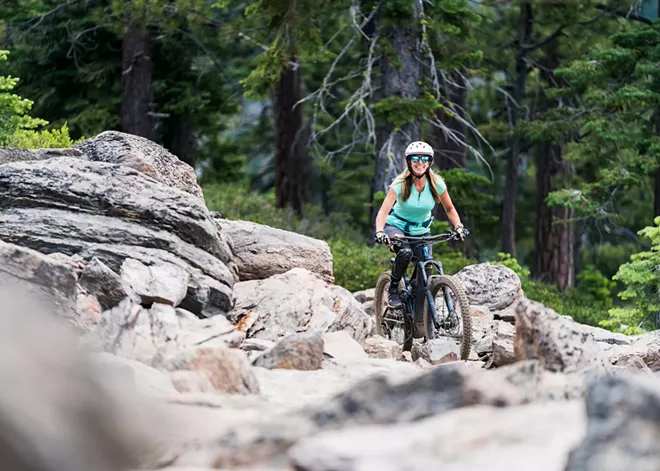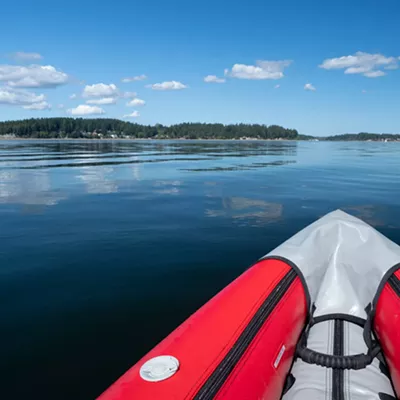Greg Britton fell in love with the sport of cycling decades ago. "It's great for mental health, it involves connecting with nature, it's a very humanity-oriented thing." His love of this mode of transportation/form of recreation is backed up by his vocation: he's the general manager of Spokane's Wheel Sport Bicycles. And with the rising popularity of e-bikes, Britton says this is a perfect opportunity for even more people to connect with the sport. Because e-biking really does widen accessibility to "a whole new world" of longer-distance rides, exploring new terrain and evening out the playing field, so to speak, when riding with people you may not usually be compatible with.
Mark Neupert, Wheel Sport's owner, says that e-bikes opened up the world of mountain biking to his 70-year-old father. Now, his dad is able to explore places he wouldn't have been able to before and he can ride with his son.
"It's a bonding experience for us," he says. Neupert adds that e-bikes are typically excellent options when aging brings new health challenges such as hip or knee replacements and other annoying degenerative changes. But they're also just generally a great training tool for anyone, especially if you're looking for an activity that keeps your heart rate up.
So what, exactly, is an e-bike, and how do you go about choosing one? First, you've got to know about the 1-2-3 class system. "It's a national system that companies who sell e-bikes are required to designate," Britton explains.
A Class 1 e-bike offers pedal-assist, meaning the motor will kick only when you are pedaling, and even then, only if you activate the assist. The assist turns off after the biker reaches 20 mph. It's the class that has the most in common with an "acoustic" bike.
Class 2, on the other hand, allows riders to use a throttle to engage the motor — no pedaling required — though these bikes are also limited to 20 mph. Class 2 bikes are a great option for those who may want to tackle bigger hills or longer distances.
Last and certainly not least, Class 3 bikes provide pedal-assist just like Class 1 bikes, but Class 3 bikes can reach a higher speed of 28 mph before the assist turns off. These bikes also have speedometers.

E-bikes can be intimidating for someone who isn't already a confident cyclist, but Britton says it really isn't anything foreign. "You control the bike," he says, "the bike doesn't control you." Plus, he's never seen a test drive where the rider didn't come back smiling ear to ear.
Still, misconception can be a factor that prevents customers from buying and loving e-bikes. "There are a lot of seasoned riders who turn their noses up at e-bikes," Britton says. But interestingly, there are fitness benefits to being an e-bike rider, as these riders tend to ride more frequently and for longer distances. E-biking really can be for everyone. As Spokane teeters on the brink of warmer weather, local bike shops are ready for you to try out their electric options.
"Just try it out and see what you think," Britton says.
You never know — you might just come back from your test drive smiling, as e-bike riders do, from ear to ear.
It's great for mental health, it involves connecting with nature, it's a very humanity-oriented thing.
TRAFFIC-FREE RIDES
It's not hard to ride an e-bike, but it can be more fun without cars and trucks whizzing by. Before heading out to a trail, check to see if you'll need a parking pass and make sure the class of e-bike you're riding is permitted.
CHILDREN OF THE SUN TRAIL
This paved trail stretches for just over 7 miles from the Little Spokane River to Hillyard, parallel to the North Spokane Corridor project.
CENTENNIAL TRAIL
Though the portion of this well-loved trail fro milepost 0 to 14 — that's from the Idaho stateline west to the Donkey Island trailhead in Millwood — will be closed this summer, there are still 25 miles of trail in Washington state to explore. Another 24 miles of trail extend east from the Washington/Idaho state line all the way to Coeur d'Alene.
TRAIL OF THE COEUR D'ALENES
With 73 miles of smooth asphalt, this rails-to-trails route also benefits from a gentle grade as it spans almost the entire width of the Idaho panhandle. Find more information about exploring popular sections of the trail at friendsofcdatrails.org.
— ANNE McGREGOR




















